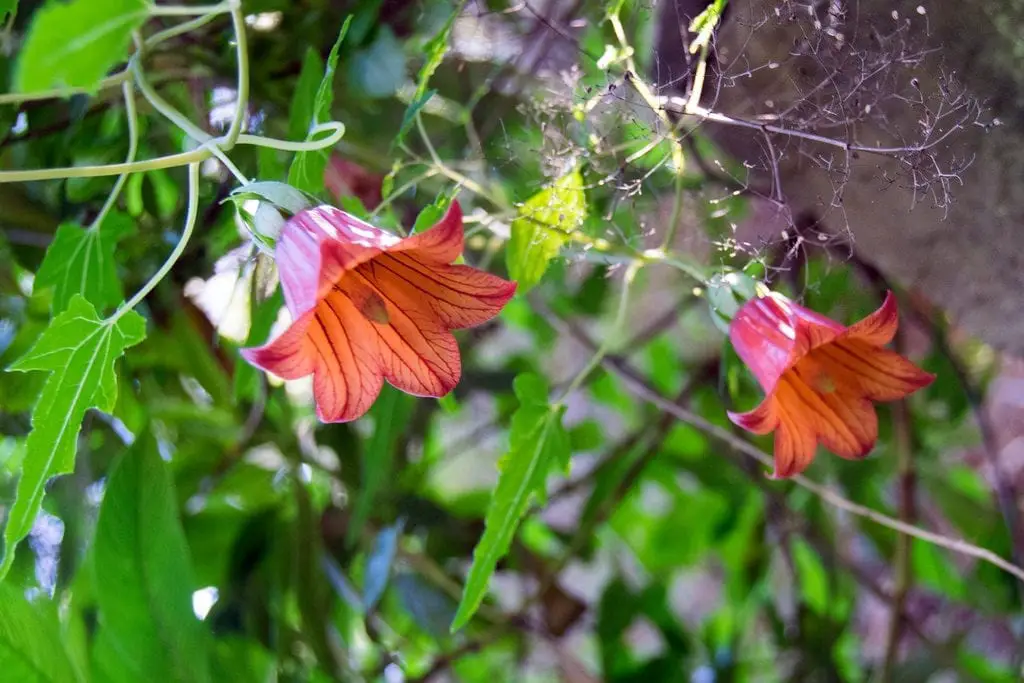
Image – Flickr / Paul Asman and Jill Lenoble
The Canarina canariensis It is a climbing plant of exceptional beauty, as it produces large bell-shaped flowers of a red color that attracts a lot of attention. Its rapid growth makes it a very interesting species to cover walls or lattices, of course, provided they are protected from direct sun.
If you want to know all the secrets that this wonderful species hides, in this special article we are going to tell you everything about her 🙂.
Origin and characteristics

Our protagonist is an endemic climbing plant of the Canary Islands, where it lives mainly in the forests of laurel. Its scientific name is Canarina canariensisalthough it is popularly known as bicacarera, bicacarero, bicacaro, or campanilla. It grows from a thick and deep tuber.
Its stems are climbing -if they have a place to hold- or hanging, fleshy, hollow, and they can measure up to 3 meters. These contain latex inside. The leaves are opposite, petiolate, covered by a white fluff, of an intense green color on the upper surface and lighter on the underside.
The flowers are bell-shapedorange or red, and are bisexual. The fruit is a fleshy black, oval berry, 3-4cm in diameter, and edible, with a sweet taste.
What are their cares?

Image – Wikimedia Commons / Joseph table
If you want to have a copy, we recommend that you provide the following care for your bicacaro:
Location
- Outdoor: place in semi-shade. It can be in full sun if the insolation is not very intense, but it prefers to be protected.
- Interior– Can be kept as a houseplant in a bright room.
Earth
- the garden: grows in fertile soils, with good drainage.
- Flower pot: plant with the following mixture of substrates: 50% black peat + 30% perlite (or similar) + 20% worm humus.
Irrigation
The bicacaro is a climber that does not resist drought at all. It must be taken into account that in laurel forests the environmental and soil humidity is high. But beware, this does not mean that you have to treat it like a water tank, because waterlogging doesn’t suit it either. Then, How often do you have to water it?
It will depend on the climate and the area where you are. Thus, while for example outdoors in Malaga (Spain) it will be necessary to water very often in midsummer, indoors in Palencia (Spain) the frequency will be less at the same time of year. Therefore, and to avoid problems, I advise you to check the humidity of the earthat least in the beginning.
For that you can use a digital moisture meter, or a simple thin wooden stick (if when you extract it you see that it comes out with a lot of adhering soil, do not water). When in doubt, it is always more appropriate to wait a couple of days before watering.
Subscriber

Guano powder.
The Canarina canariensis produces edible fruits, so that the ideal will be to pay it in spring and summer with organic fertilizerseither guano, herbivorous animal manure, egg and / or banana shells, or others that we discuss in this link..
Multiplication
It multiplies by seeds and cuttings in spring. Let’s see how to proceed in each case:
Seeds
The step by step to follow is as follows:
- First, a seedbed (pot, tray with holes, glasses of yogurt with a hole in the base, …) is filled with universal culture substrate.
- Then, it is watered conscientiously and the seeds are sown, ensuring that they are not piled up.
- Afterwards, they are covered with a very thin layer of substrate and irrigated again, this time with a sprayer.
- Finally, the seedbed is placed outside, in semi-shade but in an area with abundant light.
They will germinate in 4-5 weeks.
Cuttings
Stems that come out of the base are cut, impregnated with homemade rooting agents, and finally they are planted in pots with vermiculite (you can get it here!).
Pruning
It’s not necesary. It will be enough just to remove the dry, diseased or weak stems, as well as the withered flowers.
Rusticity
Is sensitive to cold. It is grown outdoors in subtropical climates without frost.
What uses does it have?
Ornamental
The Canarina canariensis it is a climber of great beauty. It is grown in gardens to cover lattices, walls, walls, dry tree trunks … It is also a wonderful indoor plant, which adapts well to living in these conditions.
Edible
The fruits have been consumed since the first settlers of the Canary archipelago arrived on the islands.
Curiosities

Image – Flickr / Anna Faherty
To finish, you should know that this plant was recognized by Carlos Linneowhich is considered the father of modern botany, in the years 1738. In addition, at the end of the XNUMXth century the gardens of Hampton Court (London) already had some specimens of bicacaro thanks to the fact that the British wine merchants who were in the Canary Islands sent them there.
What did you think of Canarina canariensis? It’s pretty, isn’t it? We hope you enjoy it very much, whether you choose to have it in the garden or at home 🙂.

